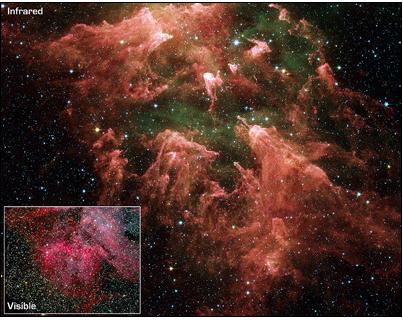Michal Levinstein, Israel Astronomical Society

The Carina Nebula as Spitzer sees it.
Credit: Spitzer.
A new image taken by NASA's Spitzer Space Telescope tells the story of the creation of a diverse stellar community by a number of monstrous stars.
The amazing image shows a collection of embryonic stars residing in the ragged and weathered environment of one of the most massive stars in the Milky Way galaxy - Eta Carinae. Astronomers say that the radiation and winds coming out of Eta Carina and its siblings tear apart the cloud of gas and dust that surrounds them and thus stimulate the formation of new stars.
"We previously knew that stars were forming in this region, but the image from the Spitzer Space Telescope shows us that the entire environment is filled with an unprecedented abundance of star embryos of different masses and ages," says Dr. Robert Gehrz from the University of Minnesota, a member of the team that made the observations.
The results were presented by Dr. Nathan Smith (Smith) - a lead researcher in the Spitzer Space Telescope project from the University of Colorado - at the 206th meeting of the American Astronomical Society held in Minneapolis.
Previous images of the region called the Carina Nebula in visible light show finger-like columns of dust all pointing toward the center of Eta Carina. Spitzer's infrared eyes were able to reveal in the dust embryonic stars that are inside the pillars as if inside an incubator and in addition star studded pillars that had not been seen before.
Eta Carina, located 10,000 light years from Earth, was once the second brightest star in the sky. It is so massive (100 times our sun) that it can barely hold itself together. Over time it paled as matter evaporated from its surface. Some astronomers speculate that it will end its life in a supernova explosion as early as our time.
The home of Eta Carina - the Carina Nebula - covers a fairly large area of 200 light years. The massive cloud of gas and dust gave birth not only to Eta Carina, but to a handful of slightly less massive sibling stars. When such massive stars are born - they immediately begin to tear apart the cloud that created them, which causes groups of new stars to form from the gas and dust. The process continues outward, causing the creation of new generations of stars. Our sun may have formed in a similar environment.
The new Spitzer image provides astronomers with a "family tree" of Eta Carina. At the top of the hierarchy are the grandfathers - Etta Karina and his brothers, and below them are generations of offspring of different sizes and ages.
"We now have a controlled experiment that helps us understand how a huge cloud of gas and dust is able to produce such a large variety of stars," says Gratz.
The non-real colors in the picture correspond to different infrared wavelengths. Red color represents dust and green color represents hot gas. Star embryos are yellow or white and the stars in the foreground of the image are blue. Eta Carina itself is at the top edge of the image - too bright to see with an infrared telescope.
